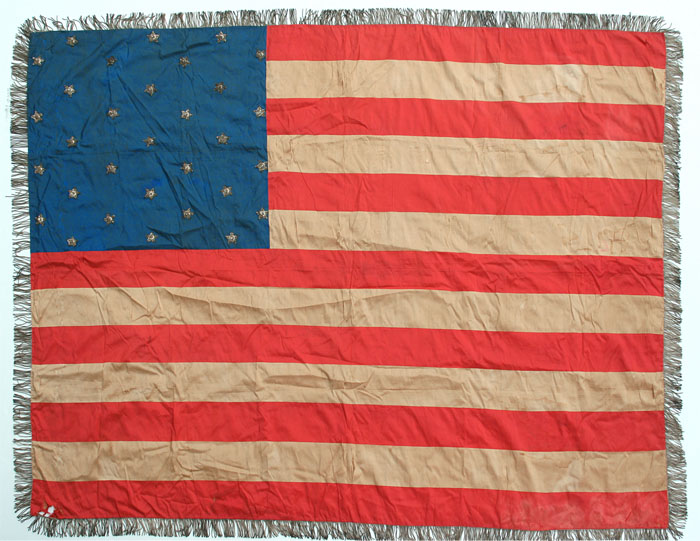
| |
31 STARS, 1850-58, CALIFORNIA STATEHOOD, SILK WITH BULLION STARS & FRINGE |
|
| Available: |
Sold |
| Frame Size (H x L): |
n/a |
| Flag Size (H x L): |
85.5" x 101" |
|
| Description....: |
|
31 STARS, 1850-58, CALIFORNIA STATEHOOD, A VERY UNUSUAL EXAMPLE, MADE OF SILK WITH BULLION STARS AND FRINGE:
31 star American national flag, made of silk, with several unusual traits. One of these is the three dimensional stars, made of metallic bullion sequins and twisted wire. Another is the beautiful, bullion fringe, which is uncommonly long. This borers all sides of the flag, which also isn't customary, as the hoist is usually devoid of such ornamentation. Another point of interest is the flag's size and proportions, which are basically those of an infantry battle flag, but slightly larger than normal. The flag measures approximately seven by eight-and-one-half feet. Civil War period (1861-65), Union infantry, military issued battle flags were silk, were nearly square in appearance, but were generally six by six-and-one-half feet. There was far less standardization in the American military before the Civil War, however, which was mostly comprised of local, volunteer militia. Surviving flags with sewn construction are generally one-of-a-kind when of pre-1861 manufacture, and this is no exception. Militia groups served more as social clubs than to for any purpose of war, and there was little in the way of the organized structure seen during the Civil War, let alone today.
The canton and stripes of the flag are made of treadle-sewn silk. The bullion fringe and stars were of Parisian manufacture, typically constructed of 98% silver and 2% gold. The flag is actually comprised of two, entire, one-sided flags, sewn back-to-back. This type of construction is especially found on early silk flags of high quality. Here there is actually a layer of fine cheesecloth between the two sides, which is not common. It served to give the flag a suppoortive inner layer of a non-silk, lightweight material, and its presence has allowed the flag to remain relatively intact over the past one-hundred-fifty plus years of its existence, even thought the silk has become brittle over time and presents the vertical splits often found in flags made of weighted silk.
Sometime between 1820 and 1850, merchants began to sell silk by weight instead of length. This encouraged them to find ways to make it heavier, which resulted in the addition of weighting agents, such as mineral salts, that were caustic to the fabric over time. Practically all silk flags made in this period through the 1920's are of weighted silk and display the associated consequences. Silk flags were the most costly, however, and retain the most beauty among surviving early examples, so less than perfect condition is far from my first concern. This flag was most certainly made for military use as a militia unit or U.S. regular battle flag. Battle flags were silk and collectors wishing to own them will suffer their losses. This is easy to do because 19th century battle flags are so rare and graphic.
The 31st state, California, entered the Union on September 9th, 1850, immediately following the Gold Rush. The 31 star flag was official from 1851-1858. Flags made prior to the Civil War are extremely rare, comprising less than one percent of 19th century flags that exist in the 21st century. This is partly because, prior to the Centennial, our flag was simply not used for most of the same purposes we employ it in today. Private individuals did not typically display the flag in their yards and on their porches. Parade flags did not often fly from carriages and horses. Places of business rarely hung flags in their windows. Use of the Stars and Stripes for these purposes began to rise swiftly during the patriotism that surrounded the Civil War, but civilian use of the flag was not widespread until 1876.
Even the military did not use the flag in a manner that most people might think. The primary purpose before the Civil War was to mark ships on the open seas. While the flag was used to mark some garrisons, the flags of ground troops were often limited to the flag of their own regiment and a Federal standard. Most people would be surprised to learn that the infantry wasn't authorized to carry the Stars & Stripes until 1837, and even then did not often exercise the right, because it was neither required nor customary. It was not until the Civil War took place that most U.S. ground forces even bothered to carry the National Flag.
Mounting: The flag has not yet been mounted.
Condition: There are some splits and losses, as noted above, but less than is typically seen in a silk flag of this size and early date, and it is surprisingly intact considering the weight of the metal stars and fringe. There is some foxing and losses and condition of the flag is as near to its original state as can possibly be expected. There is very little in the way of foxing and staining, which is also remarkable. There is a 1.5 foot section of missing fringe along the bottom. This can easily be compensated for during the mounting process. |
|
|
|
| Collector Level: |
Flags for the truest Patriots. My best offerings |
|
| Flag Type: |
Sewn flag |
|
| Star Count: |
31 |
|
| Earliest Date of Origin: |
1850 |
|
| Latest Date of Origin: |
1858 |
|
| State/Affiliation: |
California |
|
| War Association: |
1777-1860 Pre-Civil War |
|
| Price: |
SOLD |
|
| |
Views: 3347 |
|
|
|

